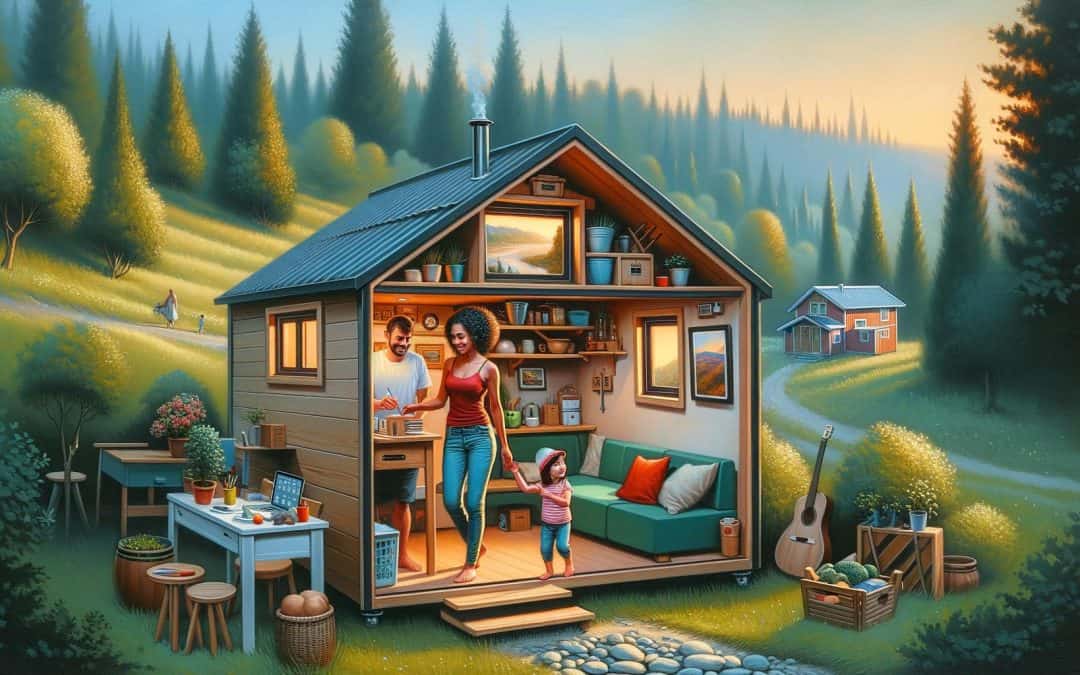Tiny homes offer a unique lifestyle, but they come with their own set of challenges. At Outbuilders, we’ve seen many aspiring tiny homeowners stumble into common pitfalls.
This guide will help you avoid tiny home mistakes, from space optimization blunders to legal and financial oversights. We’ll share practical tips to ensure your tiny living dream doesn’t turn into a nightmare.
Space Optimization in Tiny Homes: Maximizing Every Inch
Space optimization forms the foundation of successful tiny home living. Let’s explore effective strategies to maximize every square inch of your compact dwelling.
Vertical Storage: Reaching New Heights
When floor space is limited, look up. Vertical storage solutions transform tiny homes. Install floor-to-ceiling shelving units, use hanging organizers, and incorporate over-door storage.
Multi-Functional Furniture: Double-Duty Designs
Furniture that serves multiple purposes is a game-changer. A bed with built-in drawers, a dining table that converts to a workspace, or a couch with hidden storage can significantly boost your home’s functionality. A survey by Apartment Therapy reveals that 78% of tiny home dwellers consider multi-functional furniture essential for comfortable living.
Smart Organization Systems: A Home for Everything
Efficient organization systems keep tiny homes tidy and functional. Use drawer organizers or small containers to store items like jewelry, belts, and scarves to prevent clutter in your closet.
Decluttering: Embracing Minimalism
Regular decluttering is essential in a tiny home. Try the one-in-one-out rule: remove one item for every new item you bring in. This practice not only keeps your space manageable but also promotes a minimalist lifestyle. A study in the Journal of Environmental Psychology found that living with less clutter leads to reduced stress levels and increased life satisfaction.

Space optimization in tiny homes requires ongoing attention and adaptation. As we move forward, it’s important to consider the legal and zoning issues that can impact your tiny home journey. Let’s explore these potential hurdles and how to navigate them successfully.
Navigating Legal Hurdles in Tiny Home Living
Tiny home living presents unique legal challenges. Many aspiring tiny homeowners face unexpected roadblocks due to zoning laws and building codes. Let’s explore how to avoid common pitfalls in navigating these potential hurdles.
Understanding Local Regulations
Every jurisdiction has unique rules governing tiny homes. In some areas, they’re classified as RVs, while others consider them accessory dwelling units. The American Tiny House Association reports that only about 10% of U.S. municipalities have specific tiny house regulations (this lack of standardization makes thorough research essential).

Start by contacting your local planning department. Ask about minimum square footage requirements, foundation regulations, and whether your tiny home needs to be on wheels. Some areas, like Fresno, California, have embraced tiny homes, allowing them in backyards without special permits. Others may have stricter regulations.
Securing Necessary Permits
Failure to obtain proper permits can result in hefty fines or even forced relocation. While it might seem tempting to skip this step, the long-term consequences far outweigh any short-term savings.
Work with a local contractor familiar with tiny home regulations. They can help navigate the permitting process and ensure your build meets all local codes. Even if you build the home yourself, you’ll likely need electrical, plumbing, and occupancy permits.
Addressing Parking and Land Use
Where you plan to park your tiny home is just as important as how you build it. Many municipalities have restrictions on where tiny homes can be placed. Some areas only allow them in designated tiny home communities, while others permit them on private property with certain conditions.
Research potential locations before finalizing your tiny home plans. Consider factors like access to utilities, proximity to amenities, and local attitudes towards tiny homes. Some tiny home dwellers have found success by leasing land from private property owners, but make sure to get any agreements in writing and check local laws regarding long-term RV parking.
Utility Connection Requirements
Don’t overlook the importance of utility connections. Many areas require tiny homes to connect to municipal water and sewer systems (which can be costly and complicated). Some regions allow off-grid solutions like composting toilets and solar panels, while others mandate grid connections.
Research local regulations regarding utility hookups. Factor these costs into your budget, as they can significantly impact the overall expense of your tiny home project.
Future-Proofing Your Tiny Home
As tiny home regulations evolve, stay informed about potential changes in your area. Join local tiny home communities or associations to stay updated on regulatory shifts. Consider designing your tiny home with flexibility in mind, allowing for potential modifications to meet future code requirements.
The legal landscape of tiny home living can be complex, but careful planning and research make it manageable. As we move forward, we’ll explore the financial aspects of tiny home living, including often-overlooked costs and considerations that can impact your budget and long-term satisfaction.
The Hidden Costs of Tiny Home Living
Tiny homes often appear as an affordable housing solution, but the financial reality can be more complex. Many aspiring tiny homeowners underestimate the true costs involved. This chapter explores the financial pitfalls you need to watch out for when you embark on your tiny home journey.
The True Cost of Building or Buying
The initial price tag of a tiny home can deceive you. While the average cost of a tiny home ranges from $30,000 to $60,000 (according to a report by Tiny House Build), many homeowners end up spending significantly more. Factors like custom designs, high-end finishes, and off-grid systems can quickly inflate the budget.

A study by Tiny House Nation found that 68% of tiny home builders exceeded their initial budget by an average of 15%. To avoid this, create a detailed budget that includes all potential expenses, from materials and labor to permits and site preparation. Add a 20% buffer for unexpected costs.
Ongoing Maintenance and Repairs
Tiny homes require regular maintenance to stay in top condition. The compact nature of these dwellings means that issues can quickly escalate if not addressed promptly. The National Association of Home Builders suggests homeowners should budget 1% to 3% of their home’s value a year for home maintenance.
For a $50,000 tiny home, this translates to $500 to $1,500 per year. Common expenses include roof maintenance, plumbing repairs, and HVAC system upkeep. Establish a dedicated maintenance fund and perform regular inspections to catch issues early.
Resale Value Considerations
The resale market for tiny homes is still evolving, and values can be unpredictable. Unlike traditional homes, tiny houses often depreciate in value, similar to RVs or mobile homes. A study found that tiny homes on wheels typically depreciate about 10% over 16 years.
To protect your investment, focus on quality construction and design choices with broad appeal. Consider building on a foundation if local regulations allow, as this can improve long-term value. Keep detailed records of all improvements and maintenance to demonstrate the home’s worth to potential buyers.
Insurance and Financing Challenges
Insuring and financing a tiny home can be tricky. Many traditional home insurance policies don’t cover tiny homes, especially those on wheels. Specialized tiny home insurance can be more expensive, with premiums ranging from $500 to $1,500 annually (data from Insurance.com).
Financing can also challenge you. Most banks don’t offer traditional mortgages for tiny homes. Instead, you might need to explore RV loans, personal loans, or tiny home-specific financing options. These often come with higher interest rates and shorter repayment terms.
To navigate these challenges, work with insurance agents and lenders who specialize in tiny homes. Try joining tiny home associations or online communities to get recommendations and learn from others’ experiences.
Final Thoughts
A tiny home journey requires careful consideration and planning. You must understand local zoning laws, building codes, and utility requirements before you start. Explore various design options and storage solutions to maximize your compact living space. Create a comprehensive budget that accounts for initial costs and ongoing expenses.

Tiny home living can lead to increased financial freedom and a smaller environmental footprint. However, you must approach this decision with realistic expectations. Take your time, do your homework, and seek advice from experienced tiny home dwellers or professionals in the field.
At Outbuilders, we can help you avoid tiny home pitfalls and make the most of your space. Our expertise in crafting durable, personalized structures can assist you in creating the perfect complement to your tiny home lifestyle. Contact us to turn your tiny home aspirations into a fulfilling and sustainable reality.







Recent Comments